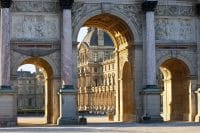
Rococo Style: How it Distincts in Architecture, Furnishings and Painting
Rococo Style: Birth and Development The Rococo, as a reflection of the trends, tastes and way of life of France…
No products in the cart.
€8.800,00
eighteenth century
with frame 56 x 75 cm
Pair of views of Rotterdam: The Stock Exchange building/ View of the canal with the ancient port
Eighteenth-century landscape painter
oils on canvas
47 x 66 cm. – with frame 56 x 75 cm.
Complete details of the pair of works: https://www.antichitacastelbarco.it/it/lavoro/coppia-di-vedute-di-rotterdam–vedutista-700
This pleasant pair of paintings depicts two views of the city of Rotterdam, investigated here as lively documentaries of the habits and customs of the public life of the rich Dutch port city, as well as one of the founders of the Dutch East India Company, and is an excellent example of eighteenth-century Vedutism.
We see, in particular, in the first work the monumental Stock Exchange Palace (defined as The Beurs), designed by the architect Adriaen van der Werff in Westnieuwland, initially a place intended for legislating on trade, where trader-bankers met periodically to exchange securities credit and stipulate sales; it is placed on the bank of the Nordblaak river and taken with Gaapers bridge in the foreground.
In the second work the docking of the ancient port of Rotterdam is immortalized, with the view in the foreground of the two gates of the city (the Wester Old Hoofdpoort on the left and the Ooster Oude Hoofdpoort on the right); in the background on the left the St. Laurenskerk (Church of St. Lawrence), also called the Great Church of Rotterdam, is the only medieval structure, while on the right the English Church.
Very well executed, characterized by a marked brightness and a chromatic range of lively shades and highlighted by the contrast between light and shadow, our canvases appear to be a very interesting testimony of eighteenth-century Rotterdam, portraying two of the glimpses that historically had a great impact on economic history of the city.
We can attribute its authorship to an author of the mid-eighteenth century, inspired by the pictorial style of the Italian Vedutisti and whose iconography was presumably drawn from the numerous perspective view prints created through optical cameras.
In particular, these views of Rotterdam draw their iconographic origin from a collection of perspective prints of the most influential European cities, created by the engraver Johann Balthasar Probst (1732-1801), characterized by a remarkable finesse in the line, at the service of a sense of perspective of undoubted value, and above all characterized by a strong Nordic taste.
Descendant of a large family of engravers from Augsburg, Probst contributed to making his workshop an important European publishing center between the 700th and XNUMXth centuries, among the major German print publishers in the first half of the XNUMXth century.
Despite his travels, including in Italy, between Venice, Rome and Naples, not all the cities he portrayed were drawn from life but taken from previous prints and drawings and filtered through Northern European clichés.
Many of these engravings have been lost and are now difficult to find on the antiques market.
The original models of the present works are today kept in the Rijksmuseum:
https://www.rijksmuseum.nl/en/collection/RP-P-1921-716
https://www.rijksmuseum.nl/en/collection/RP-P-1921-722

Rococo Style: Birth and Development The Rococo, as a reflection of the trends, tastes and way of life of France…

The Empire style, with its magnificent fusion of majesty and grace, remains an icon of classic furnishings, exerting a timeless charm…

Giò Ponti is one of the artists who most dominated the Italian post-war period, acting as a spokesperson for important innovations in the world…
€8.800,00
have viewed this article in the last 30 minutes.